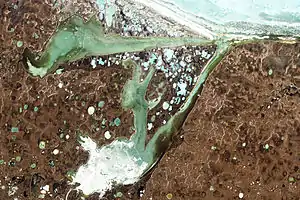Northeast Siberian coastal tundra
The Northeast Siberian coastal tundra ecoregion (WWF ID: PA1107) is an ecoregion that covers the coastal plain of the central north region of Siberia in Russia. This coastal region borders the Laptev Sea and the East Siberian Sea, both marginal seas of the Arctic Ocean, from the Lena River delta in the west to the Kolyma River delta in the east. There are several large river deltas in the area that support breeding grounds for 60 to 80 species of migratory birds. The region is in the Palearctic realm, and the tundra biome. It has an area of 846,149 square kilometres (326,700 sq mi).[1] [2]
| Northeast Siberian coastal tundra | |
|---|---|
 Omulyakhskaya and Khromskaya Bays, Northern Siberia. Note the thermokarst lakes. | |
 Ecoregion territory (in purple) | |
| Ecology | |
| Realm | Palearctic |
| Biome | tundra |
| Geography | |
| Area | 222,480 km2 (85,900 sq mi) |
| Countries | Russia |
| Coordinates | 70.75°N 146.75°E |
Location and description
The ecoregion stretches 1,100 km along the north coast of Siberia, from the Lena River delta in the west to the Kolyma River delta in the east. The terrain is flat and rolling tundra. The entire region is on continuous permafrost. Thermokarst lakes are common, caused by the freezing and thawing of permafrost.
Climate
The region has a Humid continental climate - cool summer subtype (Koppen classification Dfc). This climate is characterized by high variation in temperature, both daily and seasonally; with long, cold winters and short, cool summers with no averaging over 22 °C (72 °F). Mean precipitation is about 200 mm/year. The mean temperature at the center of the ecoregion is −37 °C (−35 °F) in January, and 11.1 °C (52.0 °F) in July.[3]
Flora and fauna
Plants of the ecoregion are those typical of the tundra landscape, with some isolated strands of larch taiga in the southern sectors. Dwarf shrubs, grasses, sedges, and moss are dominant. Common plant families include cotton grasses (Eriophorum), sedges (Carex), Dryas, willows (Salix), and various species of Vaccinium.
References
- "Northeast Siberian coastal tundra". GlobalSpecies.org. Archived from the original on December 22, 2018. Retrieved November 20, 2018.
- "Northeast Siberian coastal tundra". World Wildlife Federation. Retrieved November 20, 2018.
- "Climate Data for Latitude 70.75 Longitude 146.75". GlobalSpecies.org. Archived from the original on December 22, 2018. Retrieved February 14, 2019.